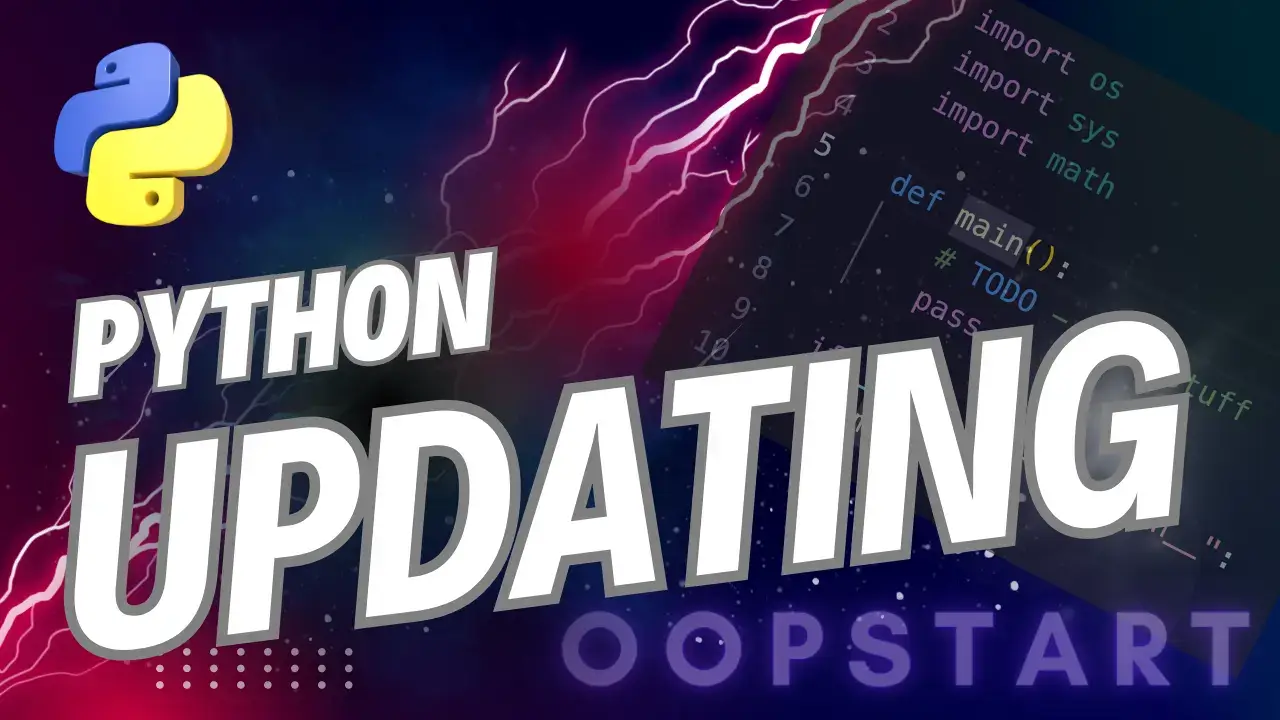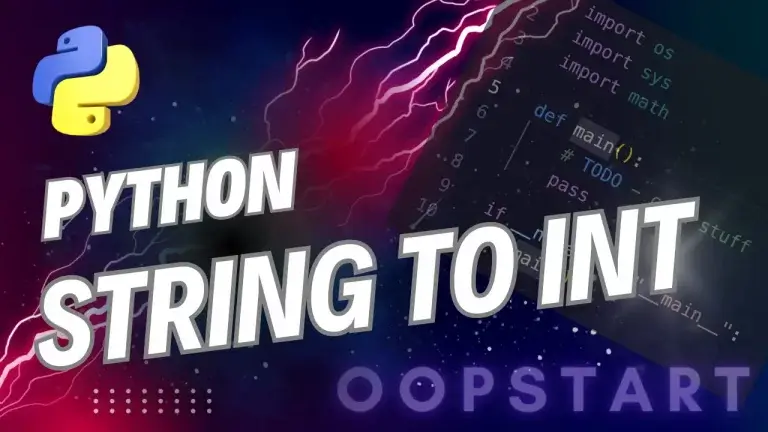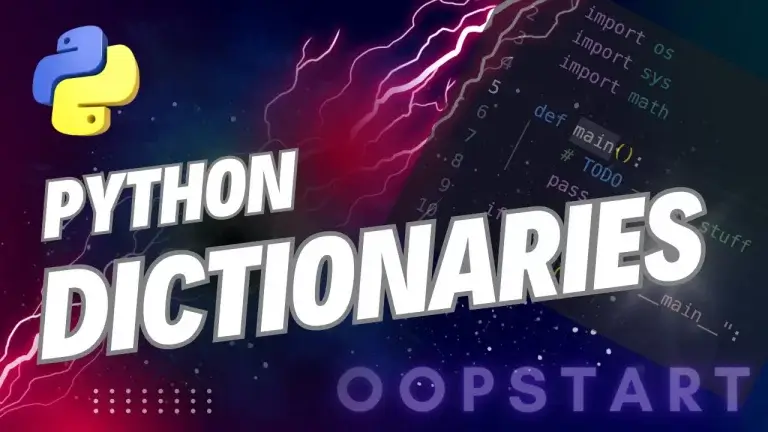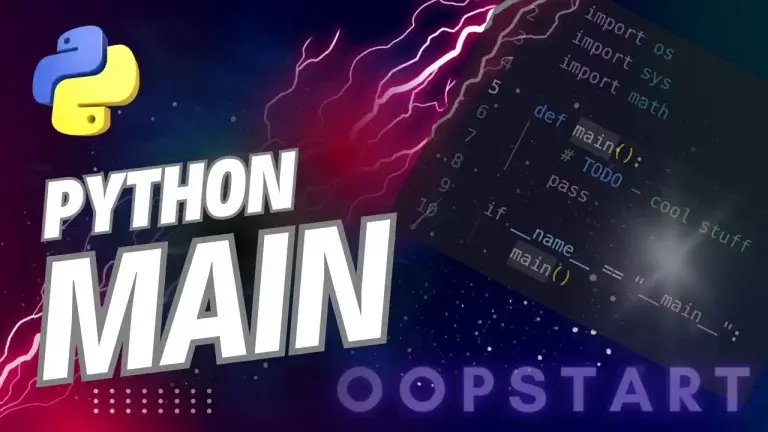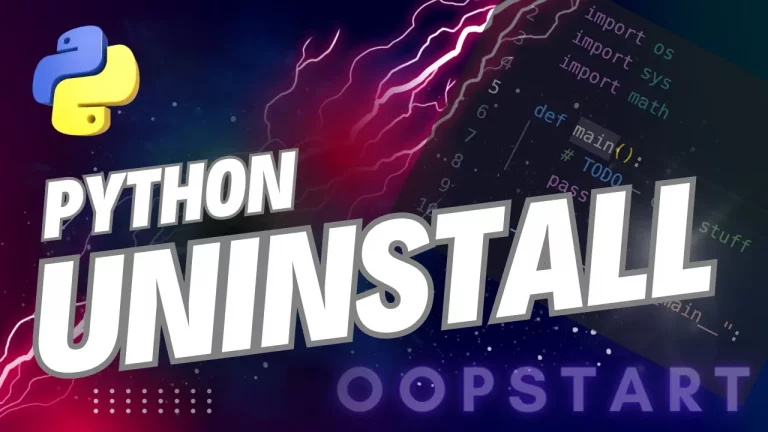How to Update Python: Comprehensive Guide
Keeping your Python installation up to date is essential to ensure you have the latest features, performance improvements, and security patches.
As Python continues to evolve, whether you’re using Python for development, data analysis, automation, or any other purpose, it’s crucial to keep Python updated to the latest version on your system to keep everything running smoothly.
By the end of this guide, you will have a clear understanding of how to update Python effectively on any platform, ensuring your development environment stays current.
Table of Contents
Why Update Python?
1. New Features
Each new version of Python introduces new features, enhancements, and libraries. Updating ensures you have access to the latest capabilities, such as:
- New syntax improvements (e.g., the
matchstatement introduced in Python 3.10). - Performance enhancements that can speed up your programs.
- New standard library modules or features.
2. Security Patches
Python regularly releases updates that address security vulnerabilities. Running an outdated version of Python could expose your system to potential risks, especially if you’re developing web applications or handling sensitive data.
3. Compatibility
Many Python libraries and frameworks (e.g., Django, Flask, NumPy) update to support newer versions of Python. If you’re working with such tools, updating Python helps ensure compatibility with the latest versions of these libraries.
Checking Your Current Python Version
Before updating Python, it’s important to check which version you are currently using. You can check the installed Python version using the following command in your terminal or command prompt:
On Windows, macOS, and Linux:
python --version
Or, if Python 3 is installed as python3 on your system:
python3 --version
Example Output:
Python 3.9.6
Once you know your current version, you can decide whether to update to the latest version.
How to Update Python on Windows
Updating Python on Windows can be done using several methods. Below are two of the most common and reliable methods.
Method 1: Updating Python Using the Python Installer
The easiest way to update Python on Windows is to download and install the latest version from the official Python website.
Step-by-Step Instructions:
Download the Latest Python Version:
- Go to the official Python website: https://www.python.org/downloads/.
- The website will automatically recommend the latest version for your system. Click the “Download” button.
Run the Installer:
- Open the downloaded installer.
- Important: Before clicking “Install Now,” check the box that says “Add Python to PATH”. This ensures that Python is accessible from the command line.
Install the New Version:
- Click “Install Now” to begin the installation process. This will install the latest version of Python and update your existing installation.
- If prompted, allow the installer to make changes to your device.
Verify the Installation:
- Open a command prompt and run the following command:
bash python --version - You should see the updated Python version.
Method 2: Using Windows Package Managers
You can also update Python using package managers like winget or chocolatey. These tools can simplify package management, especially if you frequently update software on your system.
Updating Python Using Winget:
winget upgrade Python.Python
Updating Python Using Chocolatey:
choco upgrade python
Both methods will automatically download and install the latest Python version.
How to Update Python on macOS
There are several ways to update Python on macOS, depending on how you initially installed Python.
Method 1: Updating Python via Homebrew
If you have installed Python using Homebrew, you can update it easily with the following commands.
Step-by-Step Instructions:
- Update Homebrew:
brew update
- Upgrade Python:
brew upgrade python
- Verify the Installation:
After the update completes, check the new version by running:
python3 --version
This method updates Python to the latest version supported by Homebrew.
Method 2: Downloading from the Python Website
You can also manually update Python by downloading the latest installer from the official website.
- Go to the Python Downloads page and download the latest macOS installer.
- Run the installer and follow the on-screen instructions.
- After installation, verify the updated version by running:
python3 --version
How to Update Python on Linux
Most Linux distributions come with Python pre-installed, but they may not have the latest version. Updating Python on Linux depends on the specific distribution you’re using. Here are the common methods for popular distributions.
Method 1: Updating Python on Ubuntu/Debian
On Ubuntu or Debian, you can update Python using the apt package manager.
Step-by-Step Instructions:
- Update the Package List:
sudo apt update
- Install the Latest Python Version:
sudo apt install python3
- Verify the Installation:
After the installation is complete, verify the updated version:
python3 --version
Method 2: Updating Python on Fedora/Red Hat
On Fedora or Red Hat, you can update Python using the dnf package manager.
- Update the Package List:
sudo dnf update
- Install the Latest Python Version:
sudo dnf install python3
- Verify the Installation:
Check the installed version by running:
python3 --version
Method 3: Installing Python from Source
For more control over the version and installation process, you can manually compile and install Python from the source on any Linux distribution.
- Download the Source Code:
Go to the Python Downloads page and download the source code for the latest Python version. - Extract the Source Code:
tar -xvzf Python-3.x.x.tgz
cd Python-3.x.x
- Configure and Install Python:
./configure --enable-optimizations
make
sudo make altinstall
- Verify the Installation:
python3.x --version
This method gives you flexibility in installing multiple Python versions side by side.
Managing Multiple Python Versions
If you’re working on multiple projects that require different Python versions, managing multiple versions of Python becomes important. There are two main tools you can use to handle this:
1. pyenv
pyenv is a Python version management tool that allows you to easily switch between different Python versions on your system.
Installation:
curl https://pyenv.run | bash
After installing pyenv, you can install and switch between multiple Python versions.
Example Commands:
- Install a specific Python version:
pyenv install 3.10.2
- Set a global Python version:
pyenv global 3.10.2
2. Virtual Environments
Using virtual environments is another method for isolating Python versions and dependencies for different projects. You can create a virtual environment for each project using the venv module.
Example:
python3 -m venv myenv
source myenv/bin/activate # Activate the virtual environment
Once activated, the virtual environment uses its own Python version and libraries, independent of the system-wide Python installation.
Common Issues When Updating Python
1. Path Issues
After updating Python, you might encounter issues with the Python PATH. If the updated version isn’t recognized in the terminal, ensure that Python’s installation directory is added to your system’s PATH environment variable.
2. Conflicting Versions
When managing multiple Python versions, you may face conflicts if certain tools or scripts are tied to an older version of Python. In such cases, using version management tools like pyenv or virtual environments helps avoid conflicts.
3. Broken Libraries or Packages
Some packages or libraries may not be compatible with the latest version of Python. Before updating, check whether your critical packages support the new version. You can test this in a virtual environment before updating system-wide.
4. Compatibility with IDEs
After updating Python, you may need to reconfigure your IDE (such as PyCharm or VSCode) to point to the new Python interpreter. Most modern IDEs allow you to change the interpreter settings easily.
Summary of Key Concepts
- Keeping Python up to date ensures you have the latest features, performance improvements, and security fixes.
- You can update Python on Windows using the Python installer or package managers like winget and chocolatey.
- On macOS, you can update Python using Homebrew or by downloading the latest version from the Python website.
- Linux users can update Python using their distribution’s package manager (e.g.,
apt,dnf) or by compiling from the source. - Tools like pyenv and virtual environments can help you manage multiple Python versions.
- After updating, always verify the installation and resolve any path or compatibility issues that arise.
Exercises
- Update Python on Your System: Follow the steps in this guide to update Python to the latest version on your operating system.
- Test Virtual Environments: Create a virtual environment with a specific Python version and install some packages. Practice switching between different virtual environments.
- Install Python from Source: If you’re on Linux, try downloading the latest Python source code and installing Python manually.
Check out our FREE Learn Python Programming Masterclass to hone your skills or learn from scratch.
The course covers everything from first principles to Graphical User Interfaces and Machine Learning
You can find more about updating for your specific platform at the official Python website.
FAQ
Q1: Do I need to uninstall my old version of Python before updating?
A1: No, you generally do not need to uninstall the previous version of Python before updating, especially on Windows and macOS. Most installers for Python will either update the existing version or install the new version alongside the old one. However, on Linux, package managers like apt or dnf will usually upgrade Python in place. If you do want to remove the old version, be cautious as some applications may still depend on it.
Q2: How do I switch between multiple Python versions after updating?
A2: You can use tools like pyenv or virtual environments to manage multiple versions of Python. On Linux and macOS, pyenv is a popular version management tool that allows you to install and switch between different versions easily. For projects that require specific Python versions, use virtual environments to isolate your dependencies and Python versions.
For example:
pyenv install 3.9.5
pyenv global 3.9.5 # Set Python 3.9.5 as the global version
Q3: After updating Python, my terminal still shows the old version. How do I fix this?
A3: This issue usually occurs because the terminal is still using the old Python version due to the PATH environment variable pointing to the older installation. To fix this, make sure the new Python installation directory is added to your PATH. On Windows, check your environment variables and move the new Python installation path to the top of the list. On macOS and Linux, you may need to modify your shell’s configuration file (.bashrc, .zshrc, etc.) to point to the updated Python version.
Example for Linux/macOS:
export PATH="/usr/local/bin/python3.9:$PATH"
Q4: Will updating Python break my installed packages or libraries?
A4: Yes, updating Python may break packages and libraries that are specific to an older version of Python, especially if those packages depend on Python’s internal behavior. When you update Python, you’ll often need to reinstall packages or recreate virtual environments. You can use tools like pip to reinstall packages:
pip install --upgrade package_name
To preserve installed packages when upgrading, you can export a list of your current environment’s packages before upgrading:
pip freeze > requirements.txt
Then, after upgrading Python, reinstall the packages using:
pip install -r requirements.txt
Q5: What’s the difference between Python 2 and Python 3, and should I update from Python 2 to Python 3?
A5: This is actually a great question. Python 2 and Python 3 are significantly different. Python 2 reached its end of life on January 1, 2020, and no longer receives updates or support. Python 3 introduces several improvements, including new syntax, better performance, and enhanced security. If you’re still using Python 2, it’s highly recommended that you update to Python 3 because modern libraries and frameworks no longer support Python 2.
To update, you can install Python 3 alongside Python 2 and use tools like pyenv to switch between versions.
Q6: After updating Python, how do I update pip to the latest version?
A6: You can update pip, the Python package manager, by running the following command in your terminal:
python -m pip install --upgrade pip
For systems where Python 3 is installed as python3, use:
python3 -m pip install --upgrade pip
This will ensure that you’re using the latest version of pip, which is important for managing and installing packages after a Python update.
Q7: Can I update Python using pip?
A7: No, pip is used to install and manage Python packages, but it cannot be used to update the Python interpreter itself. You need to update Python via the official installer, package manager (like apt, dnf, or brew), or by compiling from the source.
Q8: Can I update Python if it was installed via Anaconda or Miniconda?
A8: If Python was installed via Anaconda or Miniconda, you can update Python within your Conda environment using the conda command:
Example:
conda update python
This will update Python within your Conda environment. Keep in mind that this process is different from updating a system-wide Python installation.
Q9: How do I check if my libraries and packages are compatible with the new Python version?
A9: To check for compatibility, you can use virtual environments or tools like tox (a testing tool) to test your code with different Python versions. Additionally, you should check the documentation of any critical libraries or frameworks you rely on to ensure they support the Python version you plan to upgrade to.
Before upgrading, you can create a virtual environment with the new Python version, install your required packages, and run your tests to check for any compatibility issues.
Q10: How do I update Python on a web server or hosting environment?
A10: Updating Python on a web server depends on your hosting provider and the server configuration. Some hosting providers allow you to manage Python versions via a control panel or SSH access. If you have SSH access, you can typically update Python using a package manager (e.g., apt, dnf) or by installing it from the source.
For web hosting platforms like Heroku or AWS Lambda, you can specify the Python version in a configuration file:
- On Heroku, use the
runtime.txtfile to define the Python version. - On AWS Lambda, you can select the Python runtime version when deploying a Lambda function.
In more managed environments, you may need to consult your hosting provider’s documentation or contact their support for guidance on updating Python.

